Menus
- Sports tourers in comparison
- More torque for the Honda VFR 800 F would be desirable
- Price and range
- Kawasaki has to be forced to corner
- BMW F 800 GT is emphatically touristic
- Data and measured values
- Performance measurement
- Equipment in detail
- Scoring
- Test results
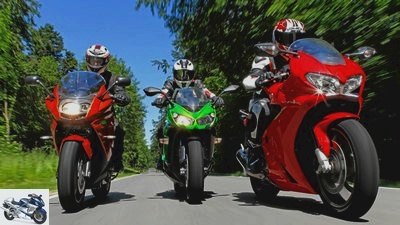
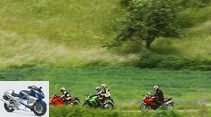

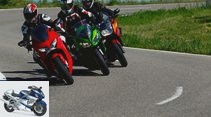
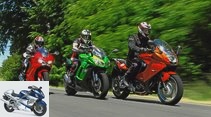
44 photos
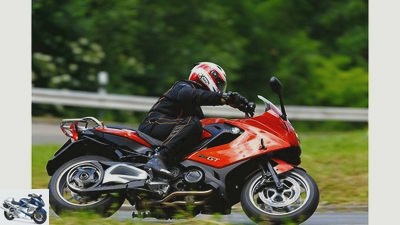
1/44
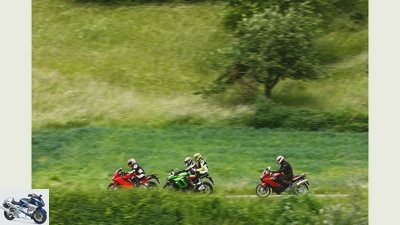
2/44
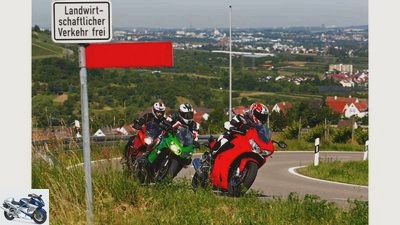
3/44
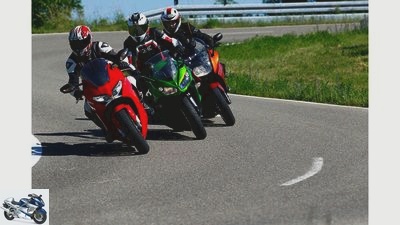
4/44
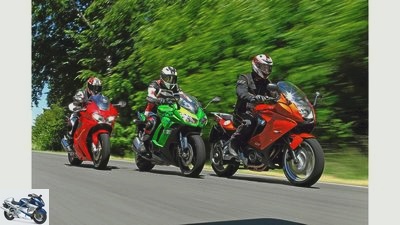
5/44
In praise of diversity: the three test candidates all want the same thing, but try to achieve it in different ways.
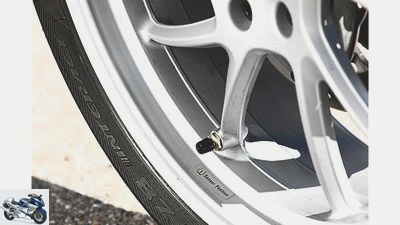
6/44
Cranked tire valves: Fumble between brake disks, sprocket carriers or belt pulleys or simply place them on the side.
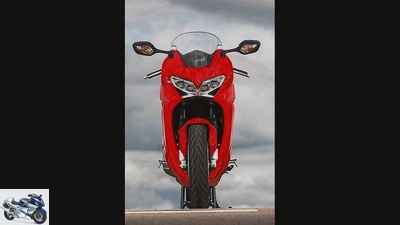
7/44
Daytime running lights: LED daytime running lights are slowly making their way into motorcycle construction. Why slow It looks good and is noticeable.
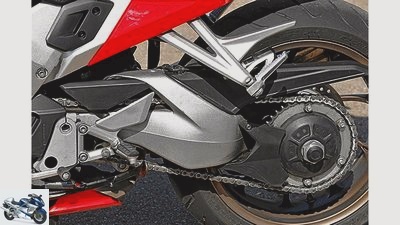
8/44
Single-sided swing arm: It leaves more space for the exhaust and this in turn benefits the storage of suitcases or saddlebags.
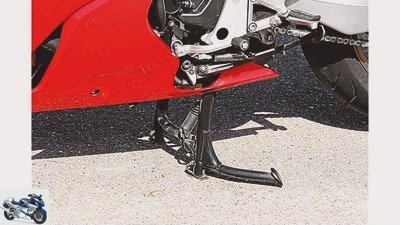
9/44
Main stand: If you have a flat tire, it is better to use a main stand. At the VFR, it also promotes chain maintenance morale – as standard.
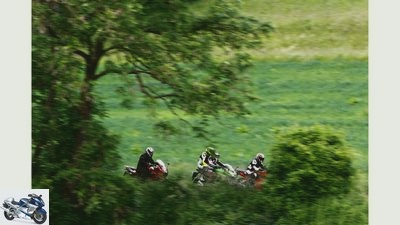
10/44
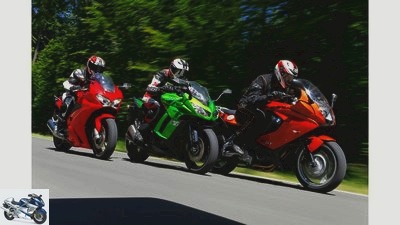
11/44

12/44
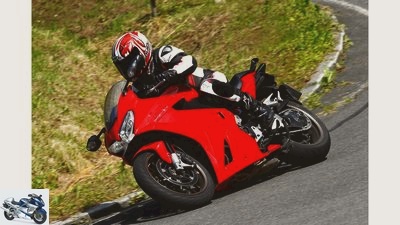
13/44
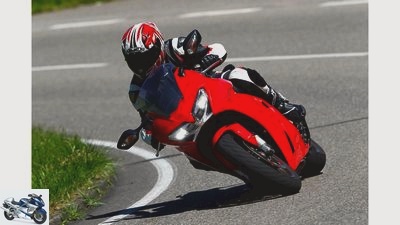
14/44

15/44
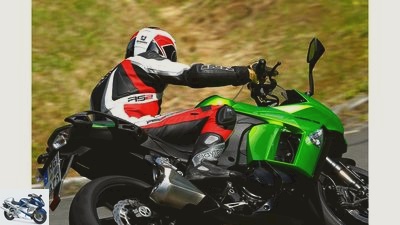
16/44
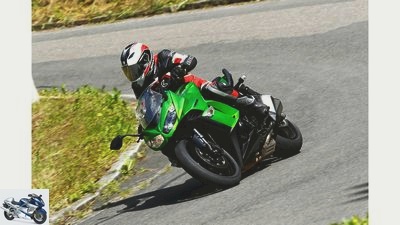
17/44
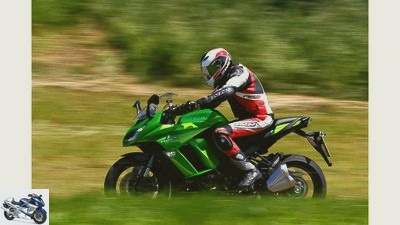
18/44

19/44
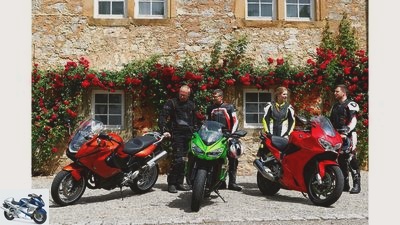
20/44
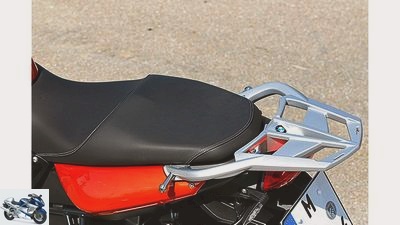
21/44
Luggage rack: in this opulence and quality only to be found on the BMW. Not even available for an extra charge at Honda and Kawasaki.
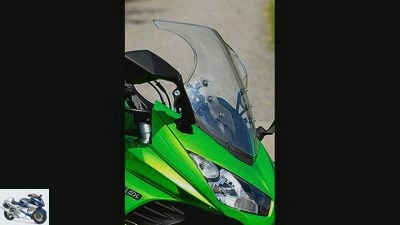
22/44
Adjustable windshield: only has the Kawasaki. The release can be found on the right in the depths of the cockpit. Please do not operate while driving.
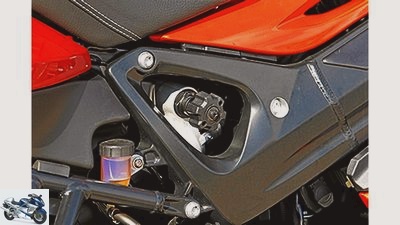
23/44
Adjustable spring base: The rear suspension of all three can be adjusted to the load condition using a handwheel.
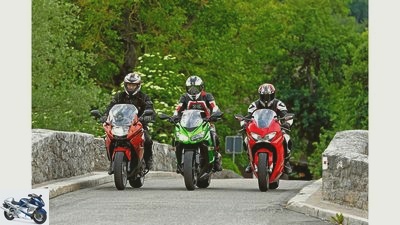
24/44
This photo shows how narrow the BMW and the Honda are built. Virtually two-cylinder, which the Honda can also do with four cylinders thanks to its V design.
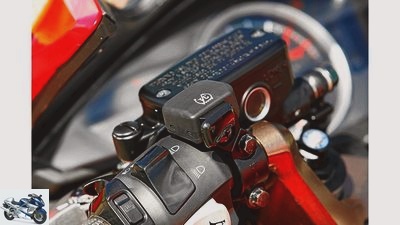
25/44
Saddled on top: the switch to turn off the traction control. During the test, the system worked inconspicuously in the best possible sense – if at all.
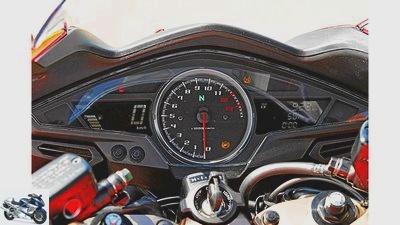
26/44
Sports tourers should offer a well-equipped cockpit. The VFR fulfills this requirement and at the same time focuses on the rev counter as the most important display.
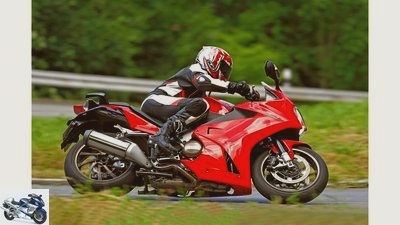
27/44
The Honda carries a large, long tank. Therefore, the driver’s seating position turned out to be rather sporty, but remains bearable even for longer tours.
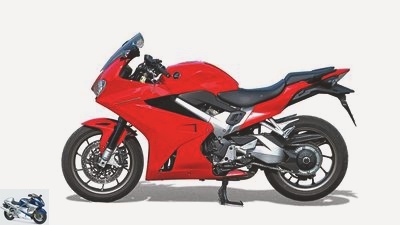
28/44
The new outfit of the revised VFR found numerous spontaneous admirers. The technique has been refined.
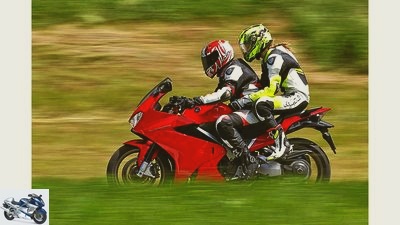
29/44
Test-Sozia Vismantha sits high, but relatively far ahead on the VFR. The knee angle and space are comfortable.
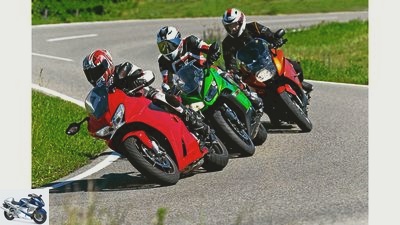
30/44
On the sporty tour: alternating curves with connoisseur asphalt are a lot of fun, especially on the Honda and the BMW.
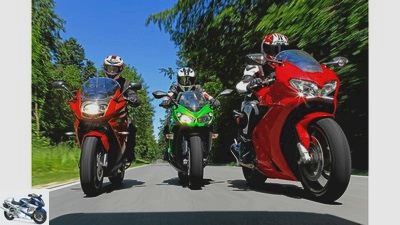
31/44
Travel sportily or drive comfortably fast – these are the main disciplines of sport touring, a type of motorcycle that was very popular in the 1990s.
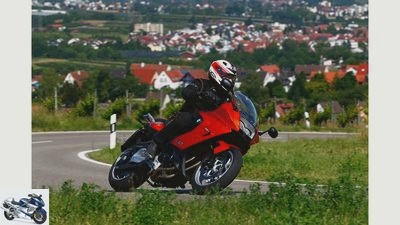
32/44
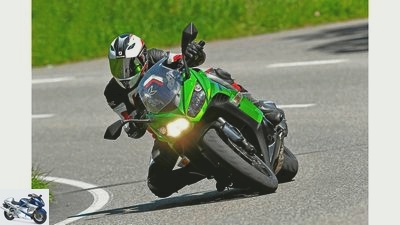
33/44
The brave colleague Schmieder bending the iron. This was preceded by several trips as a confidence-building measure.
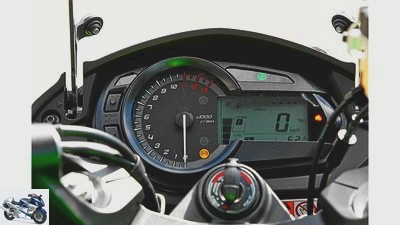
34/44
Because of the short gear ratio, the Kawa driver often looks for the imaginary seventh gear and misses the gear indicator.
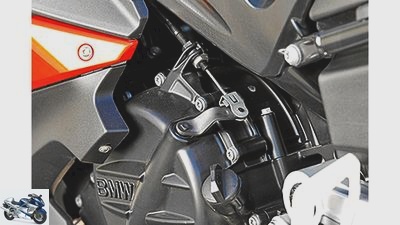
35/44
Oil level check: A sight glass would be useful, but because of the semi-dry sump lubrication, the BMW needs a dipstick.
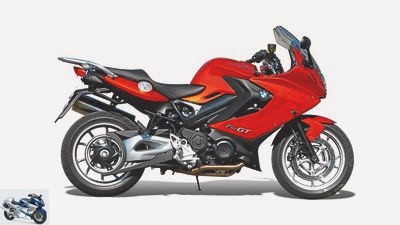
36/44
The BMW is based on the F 800 S; It became a tourer thanks to the larger fairing and the wide handlebar.
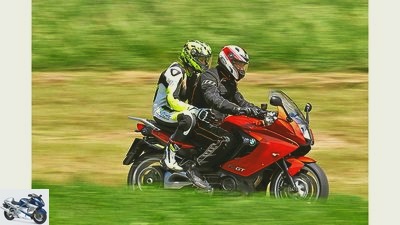
37/44
Cozy, compact and very comfortable, the passenger and driver sit on the BMW. A load of 199 kilos allows luggage for longer trips.
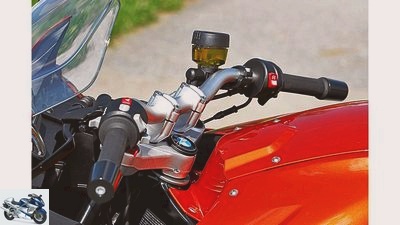
38/44
Don’t look at it, touch it: the strangely cranked tubular handlebar is perfect for the driver.
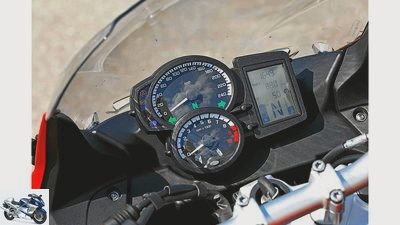
39/44
The BMW speedometer and tachometer prove that analog displays are recorded a bit faster than digital ones.

40/44
Ironically, the lightest and handiest motorcycle, the BMW F 800, offers the most comfort on long tours.
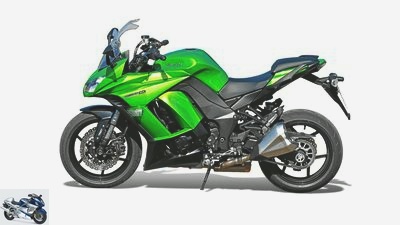
41/44
SX = Z 1000 with full cladding. Thanks to a clever mechanism, the windshield is height adjustable.
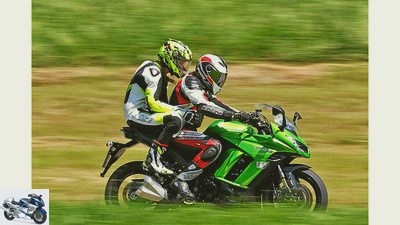
42/44
When the powerful Kawa engine starts, braces become the pillion’s top priority. Especially since the bench was quite short.
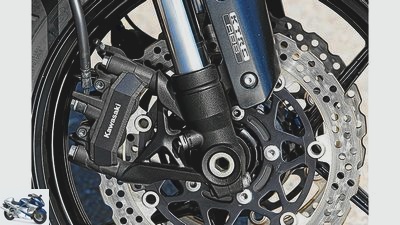
43/44
A power pack from a brake: radially screwed Tokico pliers with thick wave discs and snappy pads.
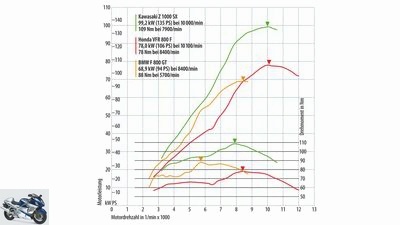
44/44
Performance measurement.
BMW F 800 GT, Kawasaki Z 1000 SX and Honda VFR 800 F in the test
Sports tourers in comparison
Travel sportily or drive comfortably fast – these are the main disciplines of sport touring, a type of motorcycle that was very popular in the 1990s. In the last few years it has been running rather outside the mainstream. Wrongly, as the varied trio of this test proves.
"There are hardly any better motorcycles, only more extreme ones." This sentence, with which the author quotes himself once, was applied to the Honda VFR 750 F from 1994, the second revised edition of the RC36. But it could just as well be applied to the whole class of motorcycles to which the VFR belongs – the sport tourers. Because if you can Kawasaki GPZ 900 R from 1984, the first VFR 750 F from 1985 or later representatives such as the Suzuki RF 900 or the Triumph Sprint models with aluminum bridge frames, which were built from 1999, you will always find motorcycles that could do a lot without being particularly prominent on a few points. Travel comfortably on the autobahn to the Nurburgring, quickly and safely do a few laps on the Nordschleife and swing home on the country roads from Eifel and Hunsruck – they mastered this triathlon like no other type of motorcycle. And if necessary, they even had camping trips for two of several weeks in their repertoire – to this day the Triumph Sprint RS is the motorcycle with the highest payload, at least 270 kilograms.
Buy complete article
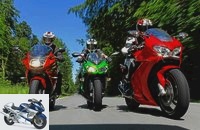
BMW F 800 GT, Kawasaki Z 1000 SX and Honda VFR 800 F in the test
Sports tourers in comparison
Choosing VFR competitors was not easy
This is still the case today, especially because Honda has revised the VFR 800 F for 2014 after a long time and thus drew attention to it again. But one thing has changed drastically: the competition or – to put it less competitive – the sports tourer family has shrunk a lot. On the one hand, more motorcycles are exploring the extremes, as can be seen in super athletes like a BMW HP4 or Ducati Panigale or in super tourers like a BMW K 1600 GT or Triumph Trophy SE. On the other hand, many drivers migrated from sports tourers to travel enduros, above all the BMW GS, since they have improved enormously in terms of driving dynamics, chassis quality and touring suitability. In addition, many manufacturers did not show a lucky hand when designing their sports tourers – see Aprilia with the Futura, BMW with the R 1200 ST or again Ducati with the ST models – and were therefore not very successful. So the offer was gradually reduced.
Choosing the VFR competitors for this comparison test was not easy, especially since Triumph recently removed the Sprint GT from its range. Despite all the apparent inhomogeneity, it makes sense, because the BMW F 800 GT is basically a variant of the first F 800, the half-clad, thoroughly sporty F 800 S, with expansive full paneling and a comfortable seating position, which is optimized for touring SX, derived from the sporty Z 1000 naked bike, offer more comfort thanks to the wind protection of their full fairing. Both are trying to expand the limits of their basic model and thus cover the same requirement profile as the Honda VFR 800 F. In contrast to the BMW F 800 GT and Kawasaki Z 1000 SX, the Honda was developed from the ground up as it stands, not as a variant of another model.
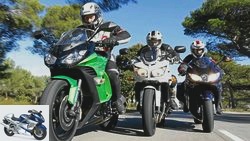
Tourer
Comparison test: sports tourer
Sports tourers from Kawasaki, Triumph and Yamaha in comparison
read more
More torque for the Honda VFR 800 F would be desirable
Because the engine housing of the V4 apparently does not allow for an increase in displacement and Honda shies away from the expense of a new design, the product planners for the Honda VFR 800 F largely retained the engine with 782 cm³. With a stroke / bore ratio of 1.5, this V4 is even designed to be shorter than the Fireblade’s engine, which has a stroke of 1.38 (55.1 mm stroke, 76 mm bore). The VFR engine was never intended for the high speeds and high liter output for which such a design is chosen. The expected torque weakness in the lower speed range with extremely short strokes should be remedied by the VTEC, a system that operates the engine as a two-valve engine below 6500 rpm and only activates two additional valves per combustion chamber above this for better filling at high speeds.
We don’t know how much torque the VFR engine would develop at low revs without VTEC, but even with it, it’s not enough to be able to follow the other two machines when pulling through in sixth gear. Pulling up the gas fully in the last gear at 60 km / h is a very practical maneuver on the powerful Kawasaki Z 1000 SX and, with slight restrictions, also on the BMW F 800 GT. Without chopping, the two react with spontaneous propulsion. On the Honda it is better to shift down two gears. At full acceleration, with the tachometer needle always in the five-digit range, the Honda VFR 800 F gets better momentum, as good as you can with 106 hp and 245 kilograms of dead weight, the highest of the test trio. The 23 kilograms lighter and, according to the test bench measurements, only 12 HP weaker BMW pulls them away, and against the powerful Kawasaki it only loses connection beyond 140 km / h. But you have to like the driving style required for this and the associated switching work.
The Honda is helped by its perfectly functioning gearbox with the exact shifting, its good to very good response and load change behavior and its smooth running. The other two have minor weaknesses here and there. For example, the rustic switching noises of the transmission of the BMW F 800 GT or the pithy vibrations of the four-cylinder engine of the Kawasaki Z 1000 SX. Ultimately, however, they convince with their voluminous torque curves. Against the courageously gripping BMW and the beefy Kawasaki, the Honda just seems weak. Nothing against engines with sharp characteristics, but they should at least outperform all others in the upper range. But the V4 doesn’t; it achieves a poor result with a lot of mechanical effort. Incidentally, that was the case when it was first published in 2002.
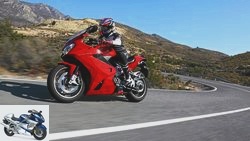
Tourer
Honda VFR 800 F in the driving report
Equipped for the future
read more
All used offers: Honda VFR 800
Price and range
Because the range plays an important role in everyday life and when touring, it is worth taking a look at the consumption and range of the three test motorcycles at this point. This shows a possible advantage of the VTEC, as the Honda VFR 800 F remains very economical with 4.5 liters per 100 kilometers. In combination with a 21.5 liter tank capacity, that’s theoretically enough for 480 kilometers. In direct comparison, the F 800 is even more economical in consumption, but has to go to the petrol station 93 kilometers beforehand because of the 15 liter tank under the seat.
Still a tight range that is usually not used without a break. The Kawasaki Z 1000 SX consumed a comparatively generous 5.5 liters on the same test lap, although it was hardly challenged. It only has a range of 345 kilometers thanks to its 19 liter tank volume. The Honda did not want to let the less successful engine rating sit on it. Even during the consumption lap, which was driven at a moderate pace, she indicated how she intended to rehabilitate herself: through consistent good behavior and thus collecting points in as many disciplines as possible. First and foremost, the majority of the chassis ratings should be mentioned. After just a few kilometers, the Honda VFR 800 F gives everyone the feeling of being a well-positioned, well-balanced, homogeneously steering motorcycle. Not necessarily because it always lulls you into safety, but rather because it lets your driver know in good time and reliably when things get unsafe. It is a phenomenon how they can reconcile conflicting properties such as handiness and cornering stability. Apparently, its developers always precisely dosed the development of these properties and balanced them out in their interaction. This does not necessarily lead to particularly prominent character traits, either positively or negatively. But to a harmonious whole.
In many ways the Honda VFR 800 F behaves so inconspicuously that only a direct comparison with its competitors reveals its qualities. The nimble BMW F 800 GT, for example, turns more easily than the VFR at medium to high speeds, but is rather bulky at low speeds due to the stiff steering damper. And while the BMW wants to descend even further in deep lean angles and the driver can only feel the approaching limit through his own reluctance to drive even more diagonally, the VFR sends very clear signals. In the area of very sporty slopes, it offers a slight resistance to violent folding. Then there is still a reserve, for example for narrowing curves, but the message gets through: From here the lions lurk. With the Honda, this even works with half-worn tires, which usually lead to a significant deterioration compared to the ideal new condition.
MOTORCYCLE market: Used BMW F 800 GT
Kawasaki has to be forced to corner
The Kawasaki Z 1000 SX deserves its own chapter on the subject of handiness and steering properties. Unfortunately not because it would be so good. Maybe it’s not that bad either. To be honest, none of the testers wanted to drive outside of a cordoned-off test area, at which point the discomfort with the steering properties announces actual front slips. Because the Z 1000 SX always offers the necessary resistance for cornering. For everything that requires more than ten degrees of inclination, she has to be forced, every bump, every bit of residual delay when turning in, she uses as an opportunity to stubbornly straighten up again. And once the tires have run 1000 kilometers behind them, things tend to get worse. Sooner or later you get tired of it. Who wants to force their machine to corner all the time? That unsettles you, the longer the more. It becomes particularly uncomfortable when driving on wet roads.
You may get used to it just riding the Kawasaki Z 1000 SX. Not, however, when alternatives with good bends take part in the same test. In search of a remedy, the MOTORRAD editors did what they shouldn’t have done – they fitted a different front tire, a Bridgestone S 20 F in the standard version instead of the special specification N. And, look, the Z 1000 SX drove like a different one . Precise, even over bumps and when braking in an inclined position, with much smaller steering corrections in wide corners than with the N-tire. Suddenly the steering gave the driver the very important feedback, the feeling of a machine that is full and safe on the front wheel. A small disadvantage of the S 20 F was already noticeable when starting off cautiously: It rolls less comfortably than the N and thus indicates that it probably does not achieve the same quality in terms of high-speed stability. It was like that, as a motorway drive with a top speed of almost 250 km / h showed. However, the Kawasaki Z 1000 SX was by no means unsafe with the other tire, it just wasn’t quite as perfectly still as before. “So, and now you put a suitcase with ten kilograms on each side, pack a loaded topcase on the back and drive out again. Then you know why no other tire apart from the N gets approval on the SX ”, commented a Bridgestone tire specialist on the test results from MOTORRAD.
Okay, if the task is to burn 250 items on the highway with suitcases and topcase without swinging, then it must be the N-tire. It’s just a shame that this very special requirement spoils the much more frequently requested harmonious cornering behavior. Either way, the abbreviation N has recently stood for “No-Go” at MOTORRAD. The only correct solution to the problem would be to build a motorcycle that drives steadily in a straight line and willingly through corners. Others can do that too.
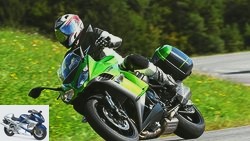
Tourer
Kawasaki Z 1000 SX (2014) in the driving report
Mild and wild combined even better?
read more
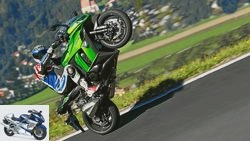
Tourer
Kawasaki Z 1000 SX in the PS driving report
More athletes than tourers?
read more
BMW F 800 GT is emphatically touristic
A particularly interesting chapter when testing sports tourers is ergonomics, because this is where the requirements for sporty and tourist driving diverge particularly widely. So the Kawasaki Z 1000 SX opts for a more sporty seating position. If you were to mount lower-positioned handlebars, the SX would come into the area of moderately designed super sports bikes.
The BMW F 800 GT, on the other hand, is more touristy. The shape of its wide tubular handlebar looks strange, but it is comfortable for the driver. In addition, it sits on the BMW with the most comfortable knee angle, without the bench being particularly high or the footrests being mounted so low that they touch down too quickly when cornering. What’s more, passengers feel particularly comfortable on the BMW; they too sit with a comfortable knee angle and have plenty of space. The position on the Honda looks a bit long and old-fashioned because of the voluminous, long tank, but proves to be comfortable even on long journeys. The passenger on the Honda VFR 800 F, like on the Kawasaki Z 1000 SX, sits quite high above the driver. For this, it is integrated a little further forward in the machine, which is more pleasant for himself and the driver.
Finally, all three motorcycles deserve great praise for an exciting test process. The tough battle for the best overall result swayed back and forth, the very different engine and chassis concepts ensure distinctive characteristics. A sign that sports tourers currently have a lot of space for interesting new developments. So, dear manufacturers, let yourself be inspired. The much-quoted “market” in a certain motorcycle segment can in part be created by yourself. That would have the advantage that not everyone else is already bustling there.
Data and measured values
engine
| BMW F 800 GT | Honda VFR 800 F. | Kawasaki Z 1000 SX | |
| design type | Two-cylinder four-stroke- In-line engine |
Four-cylinder four-stroke- 90 degree V engine |
Four-cylinder four-stroke- In-line engine |
| injection | 2 x Ø 46 mm | 4 x Ø 36 mm | 4 x Ø 38 mm |
| coupling | Multi-panes- Oil bath clutch |
Multi-panes- Oil bath clutch |
Multi-panes- Oil bath clutch |
| Bore x stroke | 82.0 x 75.6 mm | 72.0 x 48.0 mm | 77.0 x 56.0 mm |
| Displacement | 798 cc | 782 cc | 1043 cc |
| compression | 12.0: 1 | 11.8: 1 | 11.8: 1 |
| power | 66.0 kW (90 PS) at 8000 rpm |
77.9 kW (106 hp) at 10 250 rpm |
104.5 kW (142 hp) at 10,000 rpm |
| Torque | 86 Nm at 5800 rpm | 75 Nm at 8500 rpm | 111 Nm at 7300 rpm |
landing gear
| BMW F 800 GT |
Honda VFR 800 F. |
Kawasaki Z 1000 SX | |
| frame | Bridge frame aluminum |
Bridge frame aluminum |
Backbone frame aluminum |
| fork | Telescopic fork, Ø 43 mm | Telescopic fork, Ø 43 mm | Upside-down fork, Ø 41 mm |
| Steering damper | hydraulically | – | – |
| Brakes front / rear | Ø 320/265 mm | Ø 310/256 mm | Ø 300/250 mm |
| Assistance systems | ABS, traction control | ABS, traction control | ABS, traction control |
| bikes | 3.50 x 17; 5.50 x 17 | 3.50 x 17; 5.50 x 17 | 3.50 x 17; 6.00 x 17 |
| tires | 120/70 ZR 17; 180/55 ZR 17 | 120/70 ZR 17; 180/55 ZR 17 | 120/70 ZR 17; 190/50 ZR 17 |
| Tires | Metzeler Z 8 back “C” |
Dunlop Sportmax D 222 “K” |
Bridgestone S 20 “N” |
Dimensions + weight
| BMW F 800 GT | Honda VFR 800 F. |
Kawasaki Z 1000 SX | |
| wheelbase | 1514 mm | 1460 mm | 1445 mm |
| Steering head angle | 63.8 degrees | 64.5 degrees | 65.5 degrees |
| trailing | 95 mm | 95 mm | 102 mm |
| Front / rear suspension travel | 125/125 mm | 108/120 mm | 120/138 mm |
| Seat height¹ | 830 mm | 780-800 mm | 820 mm |
| Weight with a full tank¹ | 221 kg | 245 kg | 235 kg |
| Payload¹ | 199 kg | 187 kg | 191 kg |
| Tank capacity / reserve | 15.0 liters | 21.5 liters | 19.0 liters |
| Service intervals | 10,000 km | 12,000 km | 6000 km |
| price | 10 400 euros | 11,990 euros | 12,795 euros |
| Price test motorcycle | 11 550 euro² | 11,990 euros | 12,795 euros |
| Additional costs | 390 euros | 295 euros | 180 euros |
MOTORCYCLE readings
| BMW F 800 GT | Honda VFR 800 F. | Kawasaki Z 1000 SX | |
| Top speed | 224 km / h * | 242 km / h * | 249 (2441) km / h |
| acceleration | |||
| 0-100 km / h | 3.9 sec | 3.6 sec | 3.3 sec |
| 0-140 km / h | 6.5 sec | 6.0 sec | 5.3 sec |
| 0-200 km / h | 17.0 sec | 14.2 sec | 9.8 sec |
| Draft | |||
| 60-100 km / h | 4.9 sec | 5.2 sec | 3.4 sec |
| 100-140 km / h | 5.8 sec | 6.2 sec | 3.2 sec |
| 140-180 km / h | 7.4 sec | 8.6 sec | 3.6 sec |
| Consumption country road / 100 km | 3.9 liters | 4.5 liters | 5.5 liters |
| Reach country road | 385 km | 478 km | 345 km |
* Manufacturer information; 1 MOTORCYCLE measurements; ²incl. Safety package (695 euros), consisting of: ASC, ESA, RDC; Comfort package (455 euros), consisting of: case holder on the left, heated grips, on-board computer and main stand
Performance measurement
Performance measurement.
Sometimes the progress is a small dent. You can see it in the red curves of the Honda VFR 800 F. It used to acknowledge the insertion of the additional valves with a sharp point, of which only a gentle depression has remained since the revision. The noise accompanying the four-valve operation is still impressive.
The BMW two-cylinder of the precision mechanical V4 barrel organ shows almost the same displacement, which is a voluminous torque curve. It’s just a shame that the developers neglected to give it a little charm by dampening its mechanical running noises more in favor of the exhaust tone. Although it does not quite reach its rated output, the Kawasaki engine sprints the competition into the ground, also due to its exemplary power delivery.
Equipment in detail
Board computer
| BMW F 800 GT | Honda VFR 800 F. | Kawasaki Z 1000 SX | |
| Operation on-board computer | Handlebar / cockpit | cockpit | Handlebar / cockpit |
| Average / instantaneous consumption | Series / series | Series / series | Series / series |
| Average speed/ Travel time |
Series / series | Series / series | – / – |
| second trip odometer | series | series | series |
| Ambient temperature display | series | series | – |
| Engine temperature | bar | ° Celsius | – |
| Gear indicator | series | series | – |
| Fuel gauge / timer | Series (bars) / Series | Series (bars) / Series | Series (bars) / Series |
| Remaining range | – | – | series |
| On-board voltage in volts | – | – | – |
Engine / chassis
| BMW F 800 GT |
Honda VFR 800 F. |
Kawasaki Z 1000 SX |
|
| Oil level check | Dipstick | Sight glass | Sight glass |
| electronically adjustable chassis | 300 euros¹ (Rear cushioning)" |
– | – |
| different engine mappings | – | – | Series (two) |
| adjustable spring base | by handwheel | by hand wheel | by hand wheel |
ergonomics
| BMW F 800 GT |
Honda VFR 800 F. |
Kawasaki Z 1000 SX | |
| adjustable windshield | – | – | 3-stage |
| adjustable seat height | – | 2-stage | – |
| adjustable handlebar position | – | – | – |
| adjustable brake / clutch lever | Series / series | Series / series | Series/- |
Luggage
| BMW F 800 GT |
Honda VFR 800 F. |
Kawasaki Z 1000 SX | |
| Luggage hook | series | series | series |
| Case system including case holder | 537 euros | 810 euros | 834 euros³ |
| Capacity per case (l./r.) | 27/28 liters | 29/29 liters | 28/28 liters |
| Inner pockets (set) | 150 euros | 122 euros | 89 euros³ |
| Luggage rack | series | – | – |
| Storage compartment in the panel | – | – | – |
Furnishing
| BMW F 800 GT |
Honda VFR 800 F. | Kawasaki Z 1000 SX | |
| Heated grips | 200 euros² | 362 euros | 186 euros |
| Main stand | 125 euros² | series | – |
| Immobilizer | series | series | series |
| Headlight range adjustment | with tools | with tools | with tools |
| Board socket | series | – | – |
| Stainless steel exhaust system | series | series | series |
| Single-sided swing arm | series | series | – |
| Tank volume / reserve | 15 liters | 21.5 liters | 19 liters |
security
| BMW F 800 GT |
Honda VFR 800 F. |
Kawasaki Z 1000 SX | |
| Hazard warning lights | series | series | series |
| Daytime running lights | – | series | – |
| SECTION | 1-stage | 1-stage | 1-stage |
| Traction control | 1-stage (can be switched off) | 1-stage (can be switched off) | 3-stage (can be switched off) |
| Electronic tire pressure control | 210 euros² | – | – |
| cranked tire valves | series | – | – |
| Steering damper | series | – | – |
– = not available; ¹ included in the safety package (695 euros), consisting of: ASC, ESA, RDC; ² included in the comfort package (455 euros), consisting of: case holder, heated grips, on-board computer, main stand; ³ included in model variant Z 1000 SX Tourer, surcharge 780 euros (13 575 euros)
Scoring
engine
| maximum number of points | BMW F 800 GT | Honda VFR 800 F. | Kawasaki Z 1000 SX | |
| Draft | 40 | 21st | 18th | 36 |
| acceleration | 40 | 22nd | 26th | 32 |
| Top speed | 30th | 17th | 21st | 21 * |
| Engine characteristics | 30th | 19th | 16 | 26th |
| Responsiveness | 20th | 14th | 13 | 12th |
| Load change | 20th | 12th | 13 | 14th |
| Smoothness | 20th | 10 | 13 | 11 |
| coupling | 10 | 8th | 8th | 8th |
| circuit | 20th | 12th | 15th | 14th |
| Gear ratio | 10 | 7th | 7th | 8th |
| Start | 10 | 9 | 7th | 8th |
| total | 250 | 151 | 157 |
190
The first round goes to the Kawasaki Z 1000 SX, and its competitors almost go k. o. The Honda VFR 800 F stays in play only through its good behavior, the BMW F 800 GT through its robust character. Noticeable are the strong vibrations of the Kawasaki in-line engine, which penetrate the handlebars and footrests to the driver despite the rubber mountings.
Winner engine: Kawasaki Z 1000 SX
landing gear
| maximum number of points |
BMW F 800 GT |
Honda VFR 800 F. |
Kawasaki Z 1000 SX | |
| Handiness | 40 | 26th | 26th | 25th |
| Stability in turns | 40 | 28 | 29 | 29 |
| Steering behavior | 40 | 27 | 29 | 26th |
| feedback | 10 | 7th | 8th | 8th |
| Inclined position | 20th | 17th | 17th | 16 |
| Straight-line stability | 20th | 16 | 18th | 17th |
| Suspension tuning in front | 20th | 13 | 15th | 14th |
| Chassis set-up at the rear | 20th | 12th | 15th | 14th |
| Adjustment options undercarriage | 10 | 4th | 6th | 7th |
| Suspension comfort | 10 | 7th | 7th | 6th |
| Driving behavior with a passenger | 20th | 15th | 13 | 14th |
| total | 250 | 172 | 183 | 176 |
The high score of the Honda VFR 800 F does not fully reflect how harmoniously and finely balanced it drives. Handiness and stability, comfort and sufficiently firm cushioning – the VFR manages to reconcile even contradicting properties.
Chassis winner: Honda VFR 800 F
everyday life
| maximum number of points | BMW F 800 GT |
Honda VFR 800 F. |
Kawasaki Z 1000 SX | |
| Ergonomics driver | 40 | 28 | 27 | 26th |
| Ergonomics pillion | 20th | 14th | 13 | 9 |
| Windbreak | 20th | 14th | 13 | 13 |
| view | 20th | 14th | 12th | 12th |
| light | 20th | 15th | 11 | 13 |
| Furnishing | 30th | 22nd | 27 | 20th |
| Handling / maintenance | 30th | 18th | 16 | 17th |
| Luggage storage | 10 | 4th | 2 | 2 |
| Payload | 10 | 7th | 5 | 5 |
| Range | 30th | 24 | 30th | 21st |
| processing | 20th | 14th | 15th | 14th |
| total | 250 | 174 | 171 | 152 |
Here it becomes clear why the BMW F 800 GT remains a serious alternative to the better placed competitors despite the red lantern. Their high practical value and easy maintenance make them an unproblematic companion in everyday life. And it’s not boring on the home track.
Everyday winners: BMW F 800 GT
security
| maximum number of points | BMW F 800 GT | Honda VFR 800 F. |
Kawasaki Z 1000 SX | |
| Braking effect | 40 | 27 | 31 | 32 |
| Brake metering | 30th | 21st | 24 | 27 |
| Braking with a passenger / fading | 20th | 13 | 14th | 15th |
| Righting moment when braking | 10 | 8th | 7th | 5 |
| ABS function | 20th | 13 | 14th | 14th |
| Handlebar slapping | 20th | 17th | 15th | 13 |
| Ground clearance | 10 | 8th | 8th | 7th |
| total | 150 | 107 | 113 | 113 |
The Honda VFR 800 F and the Kawasaki Z 1000 SX hit a stalemate at a high level. The Kawasaki has the better brakes, the Honda the finer manners. That fits the character of the two.
Safety winner: Honda / Kawasaki
costs
| maximum number of points |
BMW F 800 GT | Honda VFR 800 F. | Kawasaki Z 1000 SX | |
| guarantee | 30th | 17th | 15th | 15th |
| Consumption (country road) | 30th | 25th | 22nd | 17th |
| Inspection costs | 20th | 17th | 18th | 10 |
| Maintenance costs | 20th | 12th | 9 | 7th |
| total | 100 | 71 | 64 | 49 |
This chapter reads like a continuation of the everyday evaluation. The winner remains the same.
Winner costs: BMW F 800 GT
Overall rating
| maximum number of points | BMW F 800 GT |
Honda VFR 800 F. |
Kawasaki Z 1000 SX | |
| Overall rating | 1000 | 675 | 688 | 680 |
| placement | 3. | 1. | 2. | |
| Price-performance note | 1.0 | 1.7 | 1.6 | 1.9 |
Price-performance winner: The Honda VFR 800 F wins the test and is hardly more expensive than the BMW F 800 GT. That brings the best price-performance rating.
* rated: MOTORCYCLE measurement
Test results
1. Honda VFR 800 F
It is the legendary sum of all properties that brings the Honda VFR 800 F forward. It scores evenly high in many ratings, just not in the engine area. The V4 does not even manage to tear the bar set high by the Kawa – it jumps through the bottom.
2. Kawasaki Z 1000 SX
Despite its great thirst, it is the extremely powerful engine that saves the Kawasaki Z 1000 SX from second place. Your stubborn steering behavior due to the front tire, which is too one-sided for stability and comfort, bothers you more than can be expressed in points.
3. BMW F 800 GT
She is only just about last, and that’s because of the engine. The parallel twin pushes plenty of torque and is economical, but does not quite offer the dynamics and smoothness of the four-cylinder. Otherwise, the BMW F 800 GT is always with the music. A nimble tourer for the price-conscious.
Related articles
-
Honda Crossrunner and Suzuki V-Strom 1000 in comparison test
fact 30th photos markus-jahn.com 1/30 Honda Crossrunner and Suzuki V-Strom 1000 in comparison test. markus-jahn.com 2/30 Honda Crossrunner and Suzuki…
-
Honda VFR 800 F in the top test
25th photos Montero 1/25 The cap pulls out gasoline by suction (negative pressure) and is opened when the tank is almost full or half full….
-
Honda NC 700 S and Yamaha XJ6 ABS in the test
17th photos 1/17 Honda NC 700 S and Yamaha XJ6 ABS in a 48 hp comparison test. 2/17 Honda NC 700 S and Yamaha XJ6…
-
Photos: fact 11 photos Honda 1/11 Honda CBR 600 F. Honda 2/11 Honda CBR 600 F. Honda 3/11 Honda CBR 600 F. Honda 4/11 Honda CBR 600 F. Honda 5/11 Honda…
-
Comparison test of the sports tourers from BMW and Honda
fact 12 pictures fact 1/12 Top brakes: radially screwed six-piston stoppers, ABS and integral actuation. fact 2/12 Builds compact and very narrow: the …
-
Comparison test sports tourer Kawasaki Z 1000 SX Tourer, Triumph Sprint GT
www. 35 pictures www. 1/35 Sports tourers sit between all chairs, but the temptation lies in this niche: there are bikes, …
-
Comparison test Honda XL 600 V Transalp against Kawasaki KLE 500
Comparison test Honda XL 600 V Transalp against Kawasaki KLE 500 Silent Stars Never made it big. Others collect prices, they are cheap. Now the …
-
Comparison test of the 1000 super sports car
Jaime de Diego 38 pictures fact 1/38 Yamaha demands 14895 euros for their completely new R1 super sports car. fact 2/38 Even without ABS, the Fireblade would …
-
Endurance test final balance MZ 1000 S
Bilski endurance test final balance sheet MZ 1000 S To be or not to be The world had to wait a long time for the sporty 1000 from Saxony. In the first endurance test …
-
fact Concept comparison Honda CBR 1100 XX Kawasaki ZX-12 R Suzuki GSX-R 1000 Suzuki GSX 1400 Yamaha FZS 1000 Fazer Yamaha FJR 1300 Six bombs The six …